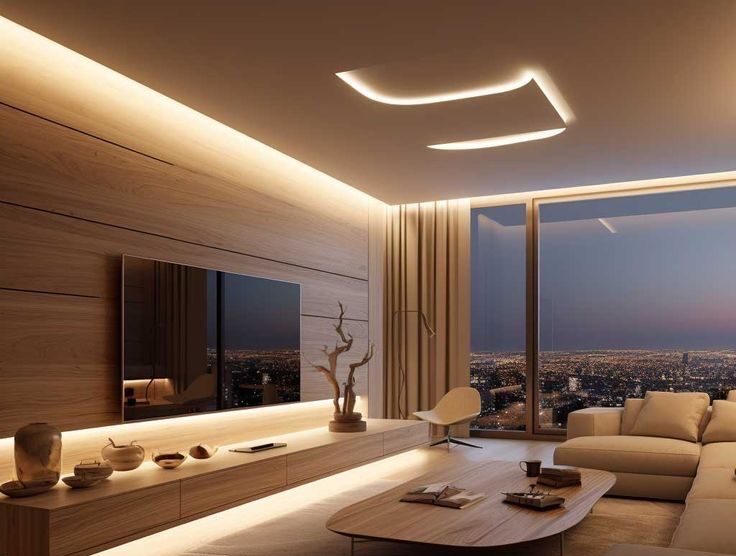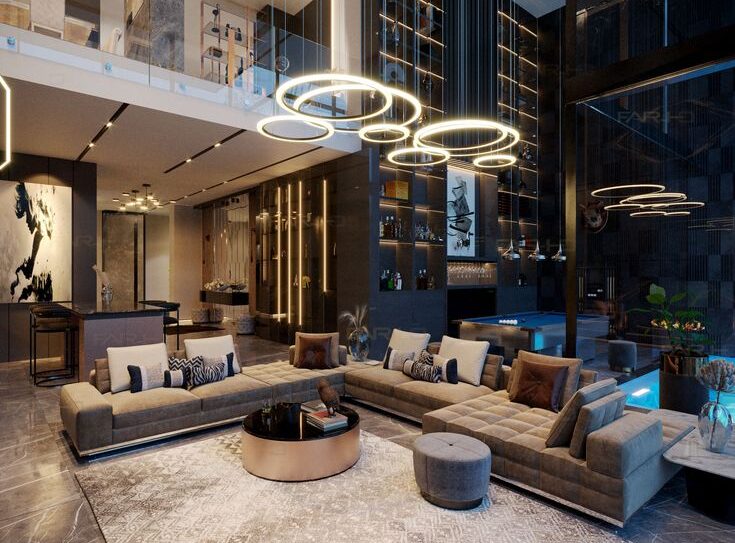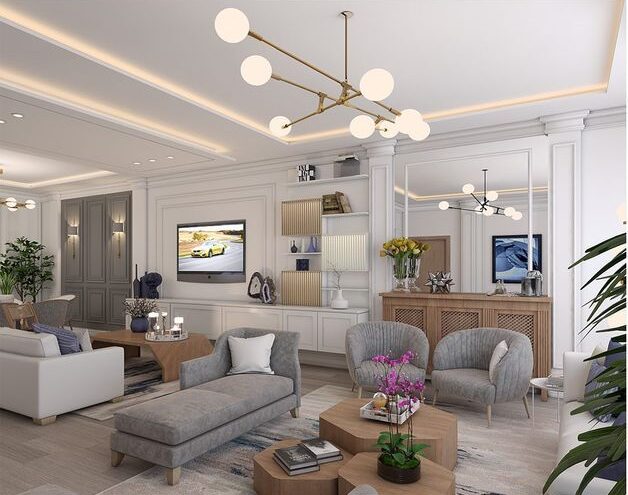Interior lighting is one of the most crucial elements in designing living and working environments, profoundly affecting the beauty, functionality, and comfort of a space. Appropriate lighting can transform the atmosphere, enhance spatial efficiency, and even influence individuals’ mental and physical well-being.
In interior lighting design, providing sufficient illumination for daily activities is essential, alongside considering aesthetic aspects. Proper use of light can highlight architectural features, accentuate specific points, and create a pleasant and calming ambiance.
The impact of interior lighting on human mood
Interior lighting is one of the most crucial factors in creating a pleasant space that influences human mood. Light not only allows us to see our surroundings but also affects our emotions, mood, and even cognitive performance.
- Biological Clock: Natural and artificial light influences our biological clock, helping to regulate the sleep-wake cycle. Daylight reduces melatonin production (the sleep hormone), boosting energy and alertness.
- Emotions: The color, intensity, and direction of light can affect our emotions. Warm and soft light creates a sense of relaxation and security, while cold and intense light may increase feelings of anxiety and tension.
- Cognitive Performance: Studies have shown that adequate and proper lighting can enhance cognitive functions, improving focus and learning efficiency.

Key Factors in Interior Lighting Design
Interior lighting is a fundamental aspect of interior design that significantly impacts the appearance, atmosphere, and functionality of a space. Choosing the right type, intensity, and color of light can create a pleasant and efficient environment. Here are some of the most important factors in interior lighting:
- Function of the Space:
- Public Spaces: Such as living rooms, require warm and soft lighting to create a cozy and intimate atmosphere.
- Workspaces: Such as home offices or kitchens, need brighter and more focused lighting to enhance concentration and productivity.
- Private Spaces: Such as bedrooms, benefit from soft and dim lighting to create a calm and relaxing environment suitable for rest.
- Size and Shape of the Space:
- Small Spaces: Use spotlights and hidden lighting to make the area feel larger.
- Large Spaces: Pendant lights and chandeliers help balance the space.
- Low Ceilings: Wall lights and hidden lighting can make ceilings appear higher.
- Colors and Materials:
- Light Colors: Reflect light better and make the space appear brighter.
- Dark Colors: Absorb light and make the space seem dimmer.
- Glossy Materials: Reflect light and enhance brightness.
- Matte Materials: Absorb light and create a darker ambiance.
- Type of Lighting:
- Natural Light: The healthiest light source, ideal for creating an energetic and inviting space.
- Artificial Light: Complements natural light and is used for nighttime illumination. Types include:
- Direct Light: Highlights objects and creates contrast.
- Indirect Light: Produces a calm and pleasant atmosphere.
- Combined Light: A mix of direct and indirect light to balance the space.
- Light Color:
- Warm Light: Includes yellow and orange hues, creating a sense of relaxation and coziness.
- Cool Light: Includes white and blue hues, fostering alertness and energy.
- Light Intensity:
- Low Intensity: Ideal for a peaceful and romantic ambiance.
- Medium Intensity: Suitable for public and workspaces.
- High Intensity: Best for areas requiring focus and precision.
- Light Direction:
- From Above: Makes the space feel more open and expansive.
- From Below: Emphasizes objects and adds depth.
- From the Side: Adds drama and a dynamic touch to the space.
Principles and Tips for Interior Building Lighting
Lighting is one of the most important elements of interior design, enhancing beauty, functionality, and the overall feel of a space. The following principles and tips can be helpful for interior lighting design:
- Lighting Categories:
Interior lighting can be divided into three main types:
- General Lighting: Illuminates the entire space, such as chandeliers or ceiling panels.
- Task Lighting: Focused lighting for specific activities like reading, cooking, or working.
- Decorative Lighting: Adds visual appeal, such as hidden lights, wall-mounted lights, or decorative fixtures.
- Considering the Function of the Space:
- Kitchen: Strong task lighting for work areas (e.g., counters, stove).
- Living Room: Adjustable and indirect lighting for a calming ambiance.
- Bedroom: Soft, warm lights with adjustable intensity.
- Bathroom: Moisture-resistant and safe lighting with a focus on mirrors.
- Home Office or Study: Focused lighting with white or natural light color temperature.

The Most Suitable Light Source for Interior Lighting
The most suitable light source for interior lighting in a building depends on the type of space, lighting needs, and overall design. However, some light sources are typically ideal due to their specific features and functionality. Below are some of these light sources:
- LED Lamps
LED lamps (light-emitting diodes) are among the best and most common light sources for interior lighting. These lamps have the following features:
- Energy Efficiency: Very low energy consumption and long lifespan.
- Color Temperature Variety: The ability to choose cool, warm, or natural light suitable for the space.
- Minimal Heat Generation: Safe and suitable for various spaces due to low heat production.
- Diverse Designs: LEDs come in various shapes and sizes, making them easy to use in different spaces.
- Fluorescent Lamps
Fluorescent lamps are also a suitable option for commercial spaces or offices. These lamps typically consume less energy compared to incandescent lamps and have a longer lifespan. Their features include:
- Wide Applications: Suitable for general lighting in large or open spaces.
- Energy Savings: Use less electricity compared to incandescent lamps.
- Uniform Light: Can provide consistent and gentle lighting for the space.
- Halogen Lamps
Halogen lamps are an excellent choice for accent and focused lighting. These lamps produce very bright light and are used to highlight specific details in a space, such as artwork, sculptures, and unique views. Their features include:
- Intense and Focused Light: Suitable for emphasizing specific elements of the space.
- Precision Lighting: Focused light creates emphasis and contrast.
- Natural Light (Windows and Daylight)
Utilizing natural light for interior lighting is one of the best and healthiest options. Natural light, especially during the day, can create a bright, pleasant, and energy-enhancing environment. This type of light is highly recommended for its positive effects on mood and health.
- Biological Benefits: Natural light increases energy and reduces fatigue.
- Energy Savings: Using sunlight reduces the need for artificial light sources.
- Ceiling Lights and Hidden Lighting
Ceiling lights and hidden lighting are among the popular solutions for general and gentle lighting. These light sources can be seamlessly integrated into the ceiling, providing uniform and indirect light across the space. This type of lighting is highly suitable for creating a relaxing and comfortable environment.

 English
English العربية
العربية

















